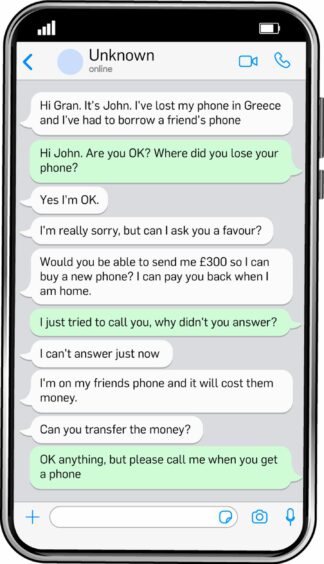A Fife police officer has shared the devastating impact electronic scams are having on pensioners – including one man who was conned out of £15,000.
The 67-year-old from west Fife was communicating by email with who he believed was an events company, and felt the need to pay after being sent various invoices.
He lost £15,000 before realising it was a scam and reporting the incident to police.
Inspector Steven Hoggan shared details of the case as one of several dealt with by his officers in Cowdenbeath, Dalgety Bay and Dunfermline in the last three months.
80-year-old thought she was taking to daughter
They include an 80-year-old woman falling victim in August.
She was led to believe her daughter was contacting her from new mobile number, requesting £1,200.
She transferred the cash, only realising it was a scam when the fraudster requested a further payment of £2,050.
Insp Hoggan is warning locals to be especially vigilant of scammers using electronic methods to target the elderly amid a national rise in these cases.
He said: “The main method deployed is to convince the victim that the perpetrator is someone close to them who has fallen on hard times.
“For example, a child who has lost their phone and has had to borrow someone else’s phone to contact the victim, or a friend who they previously worked with that has come into financial difficulty.
“The consistent aspect beyond the confidence fraud is the use of indirect electronic communication.”
In another example from July, a 70-year-old man was contacted by a scammer posing as a friend who needed money for a gift.
The victim bought £300 in Google Play vouchers and was requested to scratch the back and reveal the codes, allowing the scammer to use them online.
Insp Hoggan says the fraudsters rely on the victims being willing to help out a loved one in need.
He said: “I would encourage anyone who receives a message of this nature, by whatever means, to try to make contact with the supposed sender in the manner they would normal connect, using the details/numbers usually associated with them.
“If you cannot contact them directly, check with someone else who might have contact.”
Police can struggle to find perpetrators of scams
When the crimes are reported to police, officers can often come up against barriers in bringing the perpetrators to justice.
Insp Hoggan said: “These types of crimes can be particularly difficult to bring to prosecution as our investigations often reveal that they have initiated outwith the UK, or involve money moving to foreign bank accounts.
“In this digital age, capturing electronic evidence is a means that police and partners have become skilled in.
“However, when the trail leads to an offender beyond our jurisdiction it can be frustrating – not only for the victim but the police as well – that they may never be charged.”
Take Five
Other impacts include embarrassment caused to victims and pushing them further into isolation.
Insp Hoggan has directed people to Take Five, an online resource with advice on combatting scams.
Have you experienced an online scam? If you’d like to share your story, leave your details in the comments below. It won’t be visible to the public, but a reporter may contact you.













Conversation